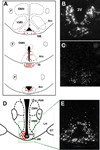Galanin-like peptide (GALP) is a hypothalamic regulator of energy homeostasis and reproduction
- PMID: 20558195
- PMCID: PMC2950899
- DOI: 10.1016/j.yfrne.2010.06.001
Galanin-like peptide (GALP) is a hypothalamic regulator of energy homeostasis and reproduction
Abstract
Galanin-like peptide (GALP) was discovered in 1999 in the porcine hypothalamus and was found to be a 60 amino acid neuropeptide. GALP shares sequence homology to galanin (1-13) in position 9-21 and can bind to, as well as activate, the three galanin receptor subtypes (GalR1-3). GALP-expressing cells are limited, and are mainly found in the arcuate nucleus of the hypothalamus (ARC) and the posterior pituitary. GALP-positive neurons in the ARC project to several brain regions where they appear to make contact with multiple neuromodulators. These neuromodulators are involved in the regulation of energy homeostasis and reproduction, anatomical evidence that suggests a role for GALP in these physiological functions. In support of this idea, GALP gene expression is regulated by several factors that reflect metabolic state including the metabolic hormones leptin and insulin, thyroid hormones, and blood glucose. Considerable evidence now exists to support the hypothesis that GALP has a role in the regulation of energy homeostasis and reproduction; and, that GALP's role may be independent of the known galanin receptors. In this review, we (1) provide an overview of the distribution of GALP, and discuss the potential relationship between GALP and other neuromodulators of energy homeostasis and reproduction, (2) discuss the metabolic factors that regulate GALP expression, (3) review the evidence for the role of GALP in energy homeostasis and reproduction, (4) discuss the potential downstream mediators and mechanisms underlying GALP's effects, and (5) discuss the possibility that GALP may mediate its effects via an as yet unidentified GALP-specific receptor.
Copyright © 2010 Elsevier Inc. All rights reserved.
Figures




Similar articles
-
Galanin-like peptide: neural regulator of energy homeostasis and reproduction.Exp Suppl. 2010;102:263-80. doi: 10.1007/978-3-0346-0228-0_18. Exp Suppl. 2010. PMID: 21299074 Review.
-
Galanin-like peptide as a link between metabolism and reproduction.J Neuroendocrinol. 2004 Aug;16(8):717-23. doi: 10.1111/j.1365-2826.2004.01221.x. J Neuroendocrinol. 2004. PMID: 15271065 Review.
-
[Galanin-like peptide (GALP): localization, receptors and biological function].Postepy Hig Med Dosw (Online). 2015 Sep 20;69:1067-76. Postepy Hig Med Dosw (Online). 2015. PMID: 26400892 Review. Polish.
-
Expression profile of Galp, alarin and their receptors in rat adrenal gland.Adv Clin Exp Med. 2019 Jun;28(6):737-746. doi: 10.17219/acem/95039. Adv Clin Exp Med. 2019. PMID: 30843677
-
Galanin/GALP and galanin receptors: role in central control of feeding, body weight/obesity and reproduction?Eur J Pharmacol. 2002 Apr 12;440(2-3):255-68. doi: 10.1016/s0014-2999(02)01433-4. Eur J Pharmacol. 2002. PMID: 12007540 Review.
Cited by
-
Reporting The Effects of Exposure to Monosodium Glutamate on The Regulatory Peptides of The Hypothalamic-Pituitary-Gonadal Axis.Int J Fertil Steril. 2021 Oct;15(4):246-251. doi: 10.22074/IJFS.2021.522615.1072. Epub 2021 Oct 16. Int J Fertil Steril. 2021. PMID: 34913291 Free PMC article. Review.
-
Neuropeptidergic Control of Feeding: Focus on the Galanin Family of Peptides.Int J Mol Sci. 2021 Mar 3;22(5):2544. doi: 10.3390/ijms22052544. Int J Mol Sci. 2021. PMID: 33802616 Free PMC article. Review.
-
Neuroanatomical Framework of the Metabolic Control of Reproduction.Physiol Rev. 2018 Oct 1;98(4):2349-2380. doi: 10.1152/physrev.00033.2017. Physiol Rev. 2018. PMID: 30109817 Free PMC article. Review.
-
Beyond Leptin: Emerging Candidates for the Integration of Metabolic and Reproductive Function during Negative Energy Balance.Front Endocrinol (Lausanne). 2011 Oct 17;2:53. doi: 10.3389/fendo.2011.00053. eCollection 2011. Front Endocrinol (Lausanne). 2011. PMID: 22645510 Free PMC article.
-
Thermoregulatory effect of alarin, a new member of the galanin peptide family.Temperature (Austin). 2014 Jul 2;1(1):51-6. doi: 10.4161/temp.29790. eCollection 2014 Apr-Jun. Temperature (Austin). 2014. PMID: 27583281 Free PMC article.
References
-
- Bartfai T, Fisone G, Langel U. Galanin and galanin antagonists: molecular and biochemical perspectives. Trends in pharmacological sciences. 1992;13:312. - PubMed
-
- Bartfai T, Hokfelt T, Langel U. Galanin—a neuroendocrine peptide. Crit Rev Neurobiol. 1993;7:229–274. - PubMed
-
- Bitran D, Hull EM. Pharmacological analysis of male rat sexual behavior. Neurosci Biobehav Rev. 1987;11:365–389. - PubMed
-
- Bitran D, Hull EM, Holmes GM, Lookingland KJ. Regulation of male rat copulatory behavior by preoptic incertohypothalamic dopamine neurons. Brain Res Bull. 1988;20:323–331. - PubMed
-
- Castellano JM, Navarro VM, Fernandez-Fernandez R, Roa J, Vigo E, Pineda R, Steiner RA, Aguilar E, Pinilla L, Tena-Sempere M. Effects of galanin-like peptide on luteinizing hormone secretion in the rat: sexually dimorphic responses and enhanced sensitivity at male puberty. Am J Physiol Endocrinol Metab. 2006;291:E1281–E1289. - PubMed
Publication types
MeSH terms
Substances
Grants and funding
LinkOut - more resources
Full Text Sources
Molecular Biology Databases

